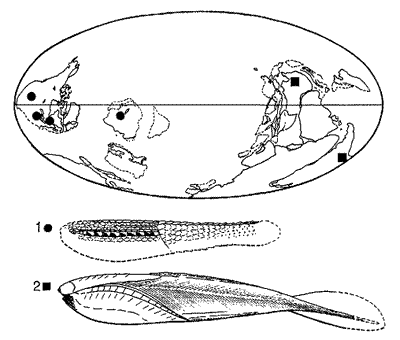
| Palaeos: |  |
Pteraspidomorphi |
| The Vertebrates | Overview |
| Page Back | Unit Home | Unit Dendrogram | Unit References | Taxon Index | Page Next |
| Unit Back | Vertebrates Home | Vertebrate Dendrograms | Vertebrate References | Glossary | Unit Next |
|
Abbreviated Dendrogram
Vertebrata |--Conodonta `--+--Thelodonti `--Pteraspidomorphi |--Arandaspida `--Heterostracomorphi |--Astraspidae `--Heterostraci |--Cyathaspidiformes | |--Cyathaspidida | `--Amphiaspidida `--Pteraspidiformes |--Pteraspididae `--Psammosteida |--Drepanaspis `--Psammosteidae |
Overview |
 |
| Pteraspis. Pragian (Early Devonian) of southeast Euramerica. Length 20 cm. Order Pteraspidiformes |
 |
| Ordovician Pteraspidomorphs: 1. Astraspida; 2. Arandaspida |
The Pteraspidomorphi include the earliest known vertebrates. The oldest certain remains date to the Early or Middle Ordovician, although the disputed and fragmentary Anatolepis probably goes back to the Furongian. In any case, by the middle and late Ordovician, there were several different lineages evolving in isolation different parts of the world, as this map indicates.
These Ordovician forms, the Arandaspida,
Astraspida
and Eriptychiida, were formerly grouped with the Silurio-Devonian Heterostraci,
but are rather more primitive. These early types share some unique
features with heterostracans, such as the presence of large median dorsal and
ventral plates, but do not possess common external branchial openings.
By the start of the Silurian
period these lineages had died out, possibly as another result of the mass
extinction at the end of the Ordovician. They were replaced by the Heterostraci.
This latter group underwent an evolutionary radiation, dividing into a number of
lineages and reaching their peak during Late Silurian and Early
Devonian times, when a variety of different types evolved and flourished,
from mud-eating bottom-dwellers to free-swimming filter-feeders. All had the
characteristic head shield, which could grow throughout the life of the animal.
By the middle Devonian the Pteraspidomorphi went into decline, with only a single family of giant (by agnath standards) flattened bottom-dwellers, the Psammosteidans, continuing almost until the end of the Devonian, the last and also the largest of the armoured jawless fish. MAK000112.
| Page Back | Unit Home | Page Top | Page Next |
checked ATW031203